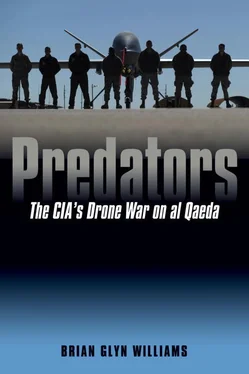The Economist presciently predicted, “The relentless advance of technology means the use of pilotless aircraft to hunt down terrorists will become more appealing to America…. The attack in Yemen will not be their last.” 15
Criticisms and fears of an expanded campaign did not, however, faze the Bush administration. President Bush subsequently declared, “The only way to treat them is [as] what they are: international killers…. And the only way to find them is to be patient and steadfast and hunt them down. And the United States of America is doing just that. We’re in it for the long haul.” 16By defending the Yemen strike, the White House was serving notice of America’s bold intention to use the latest technology available to track and kill al Qaeda members wherever they were hiding. One did not have to be versed in geopolitics to sense that that would ultimately take the Americans to Pakistan.
By this time it was clear to all that the main sanctuary that the United States was interested in denying to the terrorists was found in Pakistan’s FATA region. Even as America began its massive invasion of Iraq, which would see U.S. CENTCOM deploy more than 150,000 troops (compared to a mere ten thousand U.S. troops in the larger country of Afghanistan), the CIA persistently kept up the manhunt for the original target of the war on terror, bin Laden.
When bin Laden and his number two, Ayman al Zawahiri, had themselves filmed in 2002 walking together in the mountains of what was presumed to be the FATA, the Americans were reminded of the importance of their unfulfilled mission. The U.S. State Department began to pressure the Pakistanis to do something about the fact that the world’s most wanted terrorist and many of his accomplices were hiding out in territory nominally under their control. The White House wanted the Pakistani army to enter the autonomous tribal agencies and hunt down al Qaeda.
In July 2002 Pakistan responded to U.S. pressure by sending Pakistani troops to the FATA’s Tirah Valley (Kurram Agency) for the first time ever. Their aim was to capture bin Laden, Zawahiri, and other foreign fighters and terrorists said to be hiding there. From Tirah Valley they proceeded into the Shawal Valley of North Waziristan and then into South Waziristan. This incursion into the FATA was made possible after long negotiations with prickly local Pashtun tribes that had always enjoyed their autonomy.
But as the Pakistani troops clumsily shelled compounds and hujras where the foreign terrorists and fighters were holed up, militants among the local Waziri and Mehsud Pashtun tribes rose up against them. The Pakistani army, it seemed, had inadvertently stirred the hornet’s nest. By this time the press began to speak for the first time of the “Pakistani Taliban.” These were ad hoc militias made up of local Pashtun fundamentalist militants, many of whom had gone to fight in Afghanistan on behalf of Mullah Omar’s Taliban regime. They were joined by hundreds of Punjabi militants who had fled to Pakistan’s remote agencies in 2002, when President Musharraf, at the behest of the Americans, banned the Pakistani jihadi groups that had fought in Kashmir.
In the FATA the militants began to organize resistance to the Pakistani army and to exert their own control. They extended their power through killings and intimidation. Any malik suspected of being a moderate, a secularist, or a supporter of the “apostate” Pakistani government was brutally murdered. Hundreds of tribal leaders were hunted down and killed in this assassination campaign, especially in the agencies of Bajaur and North and South Waziristan. 17The Pakistani ISI’s Taliban chickens had finally come home to roost. A typical report from the Pakistani press described this sort of creeping conquest by the informal Pakistani Taliban as follows:
“Talibanisation has taken strong roots in Orakzai and the region is now run by the Taliban council, which has introduced sharia (Islamic) law,” tribesmen who have moved from Orakzai to escape Taliban-style rule told Daily Times on Tuesday….
They said the Taliban council had banned women from travelling outside their homes without the escort of male family members. “There is a ban on music and dancing during wedding ceremonies; working of NGOs; and development works,” they added. Each area now has its own Taliban chief and is patrolled by Taliban militants to keep the local population under the control of the TTP, the residents said. 18
Another report by the British Broadcasting Company (BBC) captures the horrors faced by average tribesmen living under the harsh rule of the ever-expanding Taliban: “They [the Pakistani Taliban] were beheading people, they were shooting innocent people without any warning, they were terrifying us…. They were stopping our kids from going to school, they were kidnapping young boys…. With my own hands I have buried 18 people who were beheaded, even children…. They are not friends, they are not our allies, they’re our enemies, they are criminals, they are gangsters.” 19
The Agence France-Presse similarly reported, “‘Everything has changed in 10 years: most of the tribal leaders have been killed and the tribal system destroyed by the Islamists. We can’t dance any more, or play music at weddings,’ said Miramshah shopkeeper Qader Gul, 56. ‘Anyone who protests risks having a member of his family kidnapped, beaten or killed.’” 20
Having brutally achieved widespread control over many of the people and much of the countryside of the FATA by late 2003, the Pakistani Taliban prepared to resist the Pakistani army. The conflict came to a head in March 2004, when Pakistani infantry and mountaineering divisions tried to storm positions held by hundreds of Pakistani Taliban troops protecting al Qaeda fighters near the South Waziristan town of Wana. The Pakistani forces were convinced that al Qaeda leader Zawahiri was among the Taliban militants and were determined to capture or kill him. But the estimated three hundred to four hundred militants fought back ferociously from their compounds and killed between sixty and a hundred Pakistani troops, once again highlighting the difficulties in using conventional means to arrest terrorists in this sort of dangerous tribal region. 21
To defuse the situation, the Pakistani government did an about-face and signed the first of many placating peace deals with the emboldened Pakistani Taliban in April 2004. The man who emerged to sign the so-called Shakai Peace Accords on behalf of the local Taliban was a charismatic South Waziristani Pashtun tribesman named Nek Muhammad. He was said never to have retreated in battle and had earned the nickname “Bogoday” (the Stubborn One).
Nek Muhammad had been forced to flee Afghanistan in 2001, when the United States invaded and the Taliban army melted away under U.S. bombs and Northern Alliance Uzbek cavalry charges. At this time Muhammad led many of his Arab and Uzbekistani jihadi compatriots across the Pakistani border to his native South Waziristan. There he and his fellow Waziri Pashtun tribemen offered the foreigners the hospitality of melmastiia . The Pakistani government insisted that the foreigners be turned over to them, but Muhammad adamantly refused to surrender fellow Muslim fighters to the U.S. puppet government of President Musharraf.
As previously mentioned, soon thereafter the Pakistani government signed the Shakai Peace Treaty with Nek Muhammad, who interpreted this treaty as a capitulation by the Pakistani army. To sign the treaty, a Pakistani general actually flew to Nek Muhammad’s territory and symbolically recognized his authority by placing a garland of flowers around his neck. As part of the treaty, Muhammad was told he had to turn over foreigners in his territory, but he promptly declared that there were no foreigners in his lands to turn over. 22Nek Muhammad had thus broken a major stipulation of the treaty before the ink on it had dried. As if to pour salt in the Pakistani army’s wounds, at this time he also promised to launch terrorist attacks throughout Pakistan to punish the government for invading South Waziristan in the first place. 23
Читать дальше












